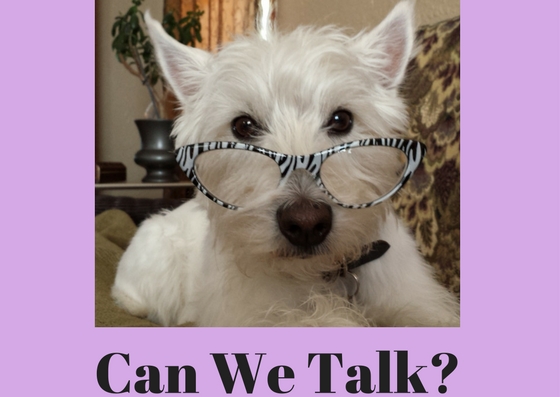For years I’ve described my work as “animal communication” and when people ask what that means I often, for the sake of brevity say, “I talk to animals”. I even use the clever phrase “Can We Talk?” with a cute photo of Hanna on the cover of a brochure. The truth is, I don’t “talk” to animals. None of us do in the way you and I talk to each other. 
What I can say is, I connect energetically with animals and in doing so, information about how the animal feels physically and emotionally comes to me. Their attitudes towards people, food, medicines, other animals and tasks in their lives come through in feelings…not words. Where they hurt, the level of pain or strong emotions is felt in my own body as I connect because I’m a highly sensitive empath. My human brain translates the feelings into words. The words “said” by the animal, are really my translation of the feelings and images I receive when energetically connected to an animal.
Here’s a good example of the “translating” that happens. Many years ago when I was just starting to communicate, I was confused by conflicting advice on what to do for my horse Smokey’s hooves. His early years on the show circuit in Tennessee had created serious hoof problems for him. One day after advice from the farrier, I said to Smokey, “I don’t know what you need. Please tell me what you need.” Clear as day I heard “Get the f**king shoes off and lower the heels”. Now, really, did Smokey know the “f” word? I don’t think so. BUT, the emotion and the intention of what he felt was best for him came through loud and clear. I followed his advice and he has done well for 20+ years. And knowing Smokey as well as I do, he would definitely use the “f” word if he knew it. He would use it often.
Animal Communication is a two-way connection and I can transmit information as well as receive it. Frequently, I use images (sent through energy from me to the animal) to help them understand behavior we humans need from them. I receive images back, apparently from the animal. What happens between the animal and me (or others) is not clearly understood by anyone. Rupert Sheldrake has conducted studies which tell us animals seem to be connected to us energetically or telepathically as there is no other explanation for how they know when their owners are returning home. He wrote about it in his book: Dogs that know when Their Owners are Coming Home. My best explanation is that we have access to all information in the “collective consciousness” and by tapping into it, we can “know” anything. Even though I may believe I understand how communication works, no one knows for absolute certain (at least until they go poof). The more we stay open to what we don’t know and remain curious, the more we allow truth to enter our experience.
There have been many times when my exchange with an animal feels like a conversation with another human. This makes the “animals don’t actually talk” piece challenging. Why this happens sometimes and not always is beyond me…and anyone else. I don’t feel compelled to know “why”. I am content with the understanding that occurs between the animal and me. The results speak the only truth I need.
Here’s a recent example of “results”. Following is a note I received from a client after working with her dog about chasing cars in the driveway, grief at the loss of his “dad” and counter surfing.
“Thank you SO MUCH for connecting with my kids. OH WHAT A DIFFERENCE it has made. Cruiser seems less depressed, and a little more comfortable with the recent changes. Cruiser has not taken ANYTHING off any flat surface since your conversation! More importantly, my boy has not chased ANY car. UPS came yesterday & the disposal truck came today (to empty the dumpster). Both are large vehicles. In the past, that was breath takingly frightening to me. Cruiser sat by the garage, & barked at them. He is also sleeping in the bedroom with me. HUGE SUCCESS HUGE RELIEF HUGE THANK YOU”
During our “conversation”, I sent Cruiser a picture of him sitting next to the garage when a vehicle came in the driveway. I also sent him the feeling of people (especially his human mommy) being pleased with him. Clearly, Cruiser got the message.
Having done this work professionally since 2000, I wouldn’t still be making a living at it if people weren’t getting results. Of course, it doesn’t always turn out this successful, and yet it often does. (And sometimes they change their behavior for 6 months to a year and then revert back, typically because a new stressor has been added to their lives). While I don’t have a definitive answer (scientifically) of how this works, I do understand what is necessary to “communicate” successfully.
My cat Red, provided me some insight. You see, Red is one of those animals who is exceptional at understanding my intention and meaning. So much so I can literally “talk to him”, out loud as if I were talking to a human and he seems to understand. Several years ago, a large family of moles had taken up residence at the farm. They were digging long trenches in the portion of yard near the house. Out loud, as if speaking to a person, I said to him, “Red, you need to help out here. These moles are ruining the yard, please do something about it.” Within 20 minutes, a mole was lying dead on the deck where I had just recently “talked” to Red. Fast forward a few months. The mole issue which improved after I spoke to Red was once again getting out of hand. Now they were attacking the garden. I “spoke” to Red, and said “The moles are a problem again. You need to do your job and take care of them. We depend on you.” About 30 minutes later, several of us were sitting near the horse paddock. I could see something in the lane out to the pasture. It was Red, but what was he doing? As Red got closer, it became evident he was “herding” a mole towards us. When he got right in front of us, the mole jumped at Red’s face, attacking him. Red looked right at me as if to say “This is not easy work”. These moles FIGHT BACK. And so, Red was able to “tell me” why his job was challenging. 
As I said, Red is an exceptional communicator. What was working here was my intention to convey my thoughts to him and his receptivity. As I teach in my classes, intention is very powerful especially when done in a state of heart coherence, something I’ve practiced for 15 years. Other important aspects to communicating effectively include, setting aside assumptions, allowing images and feelings to come through, staying out of your left analytical brain, and trusting what you get. Meditating on a regular basis is key to all the above. Exercising the right side of your brain through creative activities such as art, writing, music, etc, also helps.
Whatever you decide to call what I do with animals, I am sure the relationship between the animal and person benefits. Most who take my classes don’t intend to be professional animal communicators (I never did), they just want to understand their furry and feathered friends more clearly. In the end, whether we are talking, communicating, or whatever, doesn’t matter. It only matters that we work to understand their needs so we can provide a safe, healthy and interesting life for our companions.